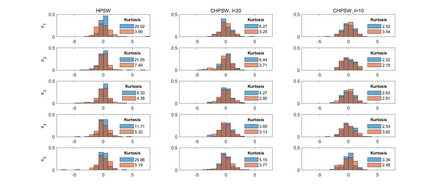Modelling multivariate systems is important for many applications in engineering and operational research. The multivariate distributions under scrutiny usually have no analytic or closed form. Therefore their modelling employs a numerical technique, typically multivariate simulations, which can have very high dimensions. Random Orthogonal Matrix (ROM) simulation is a method that has gained some popularity because of the absence of certain simulation errors. Specifically, it exactly matches a target mean, covariance matrix and certain higher moments with every simulation. This paper extends the ROM simulation algorithm presented by Hanke et al. (2017), hereafter referred to as HPSW, which matches the target mean, covariance matrix and Kollo skewness vector exactly. Our first contribution is to establish necessary and sufficient conditions for the HPSW algorithm to work. Our second contribution is to develop a general approach for constructing admissible values in the HPSW. Our third theoretical contribution is to analyse the effect of multivariate sample concatenation on the target Kollo skewness. Finally, we illustrate the extensions we develop here using a simulation study.
翻译:多变量模拟系统对于工程和操作研究的许多应用都很重要。 正在仔细研究的多变量分布通常没有分析或封闭的形式。 因此, 它们的模型使用数字技术, 通常是多变量模拟, 具有很高的维度。 随机正方位矩阵( ROM) 模拟是一种方法, 由于缺乏某些模拟错误, 已经赢得了一定的欢迎。 具体地说, 它与每个模拟中位值、 共变量矩阵和某些更高时刻完全匹配。 本文扩展了汉克等人( 2017年) 提出的ROM模拟算法, 后称为 HPSW, 与目标平均值、 共变量矩阵和 Kollo skewness 矢量完全吻合。 我们的第一个贡献是为 HPSW 算法的工作创造必要和充分的条件。 我们的第二个贡献是开发一种通用方法, 在 HPSWW 中构建可接受值。 我们的第三个理论贡献是分析多变量样本组合对目标 Kollo skewness 的效果。 最后, 我们用模拟研究来说明我们在这里开发的扩展 。
相关内容
- Today (iOS and OS X): widgets for the Today view of Notification Center
- Share (iOS and OS X): post content to web services or share content with others
- Actions (iOS and OS X): app extensions to view or manipulate inside another app
- Photo Editing (iOS): edit a photo or video in Apple's Photos app with extensions from a third-party apps
- Finder Sync (OS X): remote file storage in the Finder with support for Finder content annotation
- Storage Provider (iOS): an interface between files inside an app and other apps on a user's device
- Custom Keyboard (iOS): system-wide alternative keyboards
Source: iOS 8 Extensions: Apple’s Plan for a Powerful App Ecosystem









